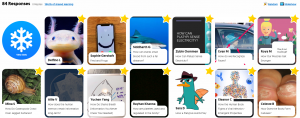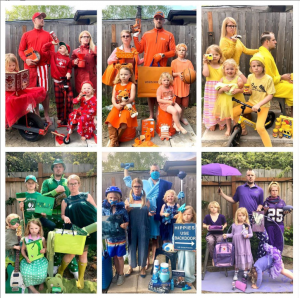(1) considers and addresses each student’s learning profile
(2) designs class activities and assignments that engage and accommodate for both individual students and a diverse group of learners
(3) builds in opportunities for each student to contribute during each class period
(4) provides alternative explanations of course concepts
(5) adapts instruction based on formative assessment
Differentiated Instruction and Assessment
(1) considers and addresses each student’s learning profile

Current Practice and Integrations overview
- Review Learning Plan before class starts and make a note of anything I need to follow up with student about
- Student Interest Survey – assignment where I ask students to tell me about themselves as a student and share their interests
- Individual Meeting outside class – One of the early assignments students need to complete is a meeting with me outside class. Some of these meetings are only 2 minutes, but others can be longer. The main benefits are that students know how to see my schedule in Outlook and send a meeting request. It also allows me to help break the ice and get to know them as people.
- Students sit in groups of four to five. This allows frequent break out discussions either in pairs or as table groups where I can walk around and determine the level of understanding and engagement of the current topic
- Individual Skill Tests – Skills Tests There are many skills students need to develop to be proficient in class and to perform labs accurately. I grade them as pass/fail because students can either do them or they can’t. There is a deadline they must be completed by, but students can practice and “test” as many times as they want. When they complete the skill they get full credit in the gradebook. When administering these tests, I can adjust the expectations based on the skill level and interests of the student without directly influencing their grade.
- The class has specific grading requirements on Canvas, but there are also many discussions and topics that we explore in class. If students are tested on more controversial issues like global warming, bio ethics, or genetically modified organisms they are asked to make an argument for their position. The grade is based on the connection between their evidence and their conclusion not on the conclusion.
- Additional readings and videos are provided in OneNote for students who want to explore topics in more depth.
In the future I would love to figure out an effective resource to record all these in one place for each student. Right now it can be very time consuming to pull together all the various aspects that make up a student and their performance in class. To have this on one page, easily accessible would be amazing. If I can find a way to make it easily accessible while teaching then I would even be able to add notes/thoughts and references in the moment. Reviewing this all together would undoubtedly enable me to gain more insight about a student and better meet their individual needs
Artifacts — here’s a partial list of a few examples of personalizations
- Student A – Very concerned about missing points and spends excessive time writing and completing all assignments. After a conversation we agree that they will be working on condensing language in all future assignments. I challenge them to write their next assignment so short that they miss points and tell them I will still give them full credit for it if we meet afterwards and talk about their submission. I keep reminding them about this until they actually miss points.
- Student B – Very anxious and tentative about speaking up in class. During our initial meeting in the fall they inform me of this and we work out a system that allows them to track their contributions to class. Identifying questions, answers and comments. We schedule a meeting to follow up in two weeks.
- Student C – Always quick to answer a question to show their knowledge and frequently corrects others when their answer is incomplete. In our second meeting, after building some rappoire we’re able to talk about why they feel pressure to always answer and be right. Also talk about how this changes the classroom environment and what it does to others willingness to ask questions and take risks. We decide they are going to wait to answer questions in class until no one else volunteers and they will look for chances to ask clarifying questions for others and try to open the door for others to participate.
- Students D/E – Choose to sit with each other in a group, but often blame each other (indirectly) for the group not being productive. The easy solution would be to separate them, but that doesn’t solve their problem. Instead, we meet outside of class and develop a plan to work together and hold each other accountable in a cooperative way.
(2) designs class activities and assignments that engage and accommodate for both individual students and a diverse group of learners

Most classes are organized lecture, discussion or activity during the first half and lab or work time during the second half. Student are left with a list of things to work on. They are ordered by priority with short-term easy tasks listed first and long-term projects at the bottom. This way students always have something to work on. The work time is sometimes individual, sometimes groups, sometimes they choose. Examples of the projects and labs outlined in the table below.
- Emergence Project– Video editing and argument. Concept of scale and structure. Future plans hope to have more student to student interaction on FlipGrid.
- Calormetry Lab – Experimentl Design, Group data collection and analysis, Excel Skills. This year I started a competition aspect of the lab with trophies. I hope to continue this in future years to create a larger data set to analyze and show the benefit of continuous improvement.
- Topic Proposal Winter Trimester – Research and Thesis Development. In the future I hope to have one of two of them published in the school newspaper or the Inspire Magazine
- Individual Lab proposal in spring. Long term planning for lab procedure and data collection. In the future I hope to have a few long term labs for them to opt into if they wish.

(3) builds in opportunities for each student to contribute during each class period
No one has 100% of the students engaged 100% of the time. I want to make sure it’s different students each day.
My goals:
- Make engagement the norm and develop social pressure to be working on biology during class.
- Create safe environment where students are comfortable taking risks.
- Ensure there are multiple ways for students to engage (email, talking during class, talking after class, meetings, surveys, assignments).
- Help students feel they are responsible for their own learning, but also supported and have help available when they need it.
Here are a few tools I use:
- Table Groups – They choose at the beginning of the year. I choose and/or make them random as the year progresses
- Surveys – can be used to ask them to reflect or as a source of anonymous student perspective to discuss and analyze in class
- Questions – Open ended discussion questions. Assigned opinions. Fact based research questions.
- Kahoot – easy way to engage class and gather information about collective understanding

(4) provides alternative explanations of course concepts
Keeping things balanced is challenging. Each student follows their own path, but I need to make sure they aren’t on a dead end. A strong stable foundation is key.
There are Major Themes that I use to hold it all together. They are introduced at the beginning of the year and spiraled back to multiple times.
The flow of class allows students get exposed to the major concepts and ideas at least 3 times before they appear in a summative exam like a project or test. This usually involves:
- reading, watching a video or short lecture to introduce a concept
- Activity or lab to explore relationships
- Assignment or discussion to pull ideas together and share different experiences or perspectives
(5) adapts instruction based on formative assessment

Much of this is addressed above as well, but here are some specifics:
- Listen to table discussions to get an idea of the depth of understanding, sometimes point out specific comments or ask a group to share
- Collect lists on whiteboard (share 1 item per group and continue until no ideas left — different person needs to speak each round)
- Forms to gather individual information and perspective
- Kahoot and in class polls to gain anonymous feedback about understanding
- Individual meetings to check in and develop a personal understanding and connection